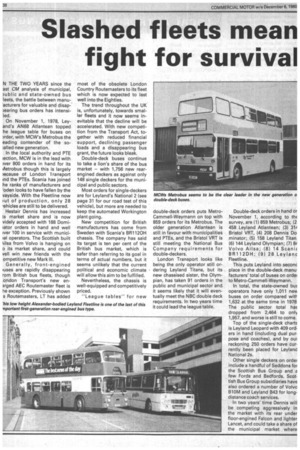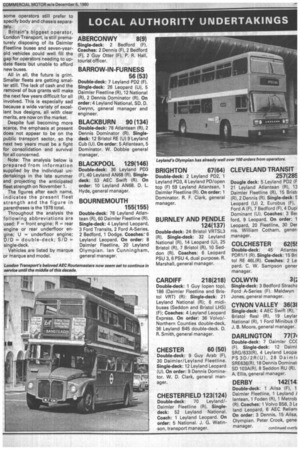Slashed fleets mean fight for survival
Page 40

Page 41

If you've noticed an error in this article please click here to report it so we can fix it.
N THE TVVO YEARS since the ast CM analysis of municipal, niblic and state-owned bus leets, the battle between menu-, acturers for valuable and disap)earing bus orders has intensiied.
On November 1, 1978, Leyand's AN68 Atlantean topped he league table for buses on 3rder, with MCW's Metrobus the eading contender of the so:ailed new generation.
In the local authority and PTE iection, MCW is in the lead with wer 800 orders in hand for its Vletrobus though this is largely )ecause of London Transport Ind the PTEs. Scania has joined he ranks of manufacturers and 'oden looks to have fallen by the vayside. With the Fleetline now )ut of production, only 28 rehicles are still to be delivered. Hestair Dennis has increased Is market share and is now videly accepted with 188 Domiiator orders in hand and well )ver 100 in service with munici)al operators. The Scottish built Oise from Volvo is hanging on o its market share, and could veil win new friends with the ompetitive new Mark III.
Generally, front-engined 'uses are rapidly disappearing ram British bus fleets, though .ondon Transport's new en3rged AEC Routemaster fleet is re exception. Previously shown s Routemasters, LT has added most of the obsolete London Country Routemasters to its fleet which is now expected to last well into the Eighties.
The trend throughout the UK is, unfortunately, towards smaller fleets and it now seems inevitable that the decline will be accelerated. With new competition from the Transport Act, together with reduced financial support, declining passenger loads and a disappearing bus grant, the future looks bleak.
Double-deck buses continue to take a lion's share of the bus market — with 1,756 new rearengined deckers as against only 148 single deckers for the municipal and public sectors.
Most orders for single-deckers are for Leyland's National 2 (see page 31 for our road test of this vehicle), but more are needed to keep the automated Workington plant going.
New competition for British manufacturers has come from Sweden with Scania's BR1120H chassis. The company has said its target is ten per cent of the British bus market, which is safer than referring to its goal in terms of actual numbers, but it seems unlikely that the current political and economic climate will allow this aim to be fulfilled.
Nevertheless, the chassis is well-equipped and competitively priced.
"League tables" for new double-deck orders puts MetroCam mell-Weymann on top with 859 orders for its Metrobus. The older generation Atlantean is still in favour with municipalities and PTEs, and the Bristol VRT is still meeting the National Bus Company requirements for double-deckers.
London Transport looks like being the only operator still ordering Leyland Titans, but its new chassised sister, the Olympian, has taken 91 orders in the public and municipal sector and. it seems likely that it will eventually meet the NBC double deck requirements. In two years time it could lead the league table. Double-deck orders in hand or November 1, according to thc survey, are (1) 859 Metrobus; (2 458 Leyland Atlantean; (3) 311 Bristol VRT, (4) 208 Dennis Do minator; (5) 158 Leyland Titan (6) 144 Leyland Olympian; (7) 8z Volvo Ailsa; (8) 14 Scanii• BR 1 1 2DH; (9) 2 8 Leylanc Fleetline.
This puts Leyland into seconc place in the double-deck manu facturers' total of buses on ordel to Metro-Cammell-Weymann.
In total, the state-owned bw operators have only 1,011 nev%
buses on order compared witl1,632 at the same time in 1978 The public sector total has dropped from 2,464 to only 1,957, and worse is still to come.
Top of the single-deck charts is Leyland Leopard with 409 ord.
ers in hand (including dual pur pose and coaches), and by our reckoning 250 orders have currently been placed for Leyland National 2s.
Other single deckers on ordei include a handful of Seddons foi the Scottish Bus Group and z few Fords and Bedfords. Scottish Bus Group subsidiaries have also ordered a number of Volvo B1OM and Leyland B43 for longdistance coach services.
In two years' time Dennis will be competing aggressively in the market with its rear under floor-engined Falcon and lighter Lancet, and could take a share of the municipal market where some operators still prefer to specify body and chassis separately.
Britain's biggest operator, London Transport, is still prematurely disposing of its Daimler Fleetline buses and seven-yearold vehicles could well fill the gap for operators needing to update fleets but unable to afford new buses.
All in all, the future is grim. Smaller fleets are getting smaller still. The lack of cash and the removal of bus grants will make the next few years difficult for all involved. This is especially sad because a wide variety of excellent bus designs, all with clear merits, are now on the market.
Despite fuel becoming more scarce, the emphasis at present does not appear to be on the public transport sector, so the next two years must be a fight for consolidation and survival for all concerned.
Note: The analysis below is prepared from information supplied by the individual undertakings in the late summer and projecting the anticipated fleet strength on November 1.
The figures after each name, indicates the present fleet strength and the figure in parentheses is the 1978 total, Throughout the analysis the following abbreviations are used: F = front engine; R = rear engine or rear underfloor engine; U = underfloor engine; D/D = double-deck; S/D = single-deck.
Vehicles are listed by marque or marque and model.












































































































































